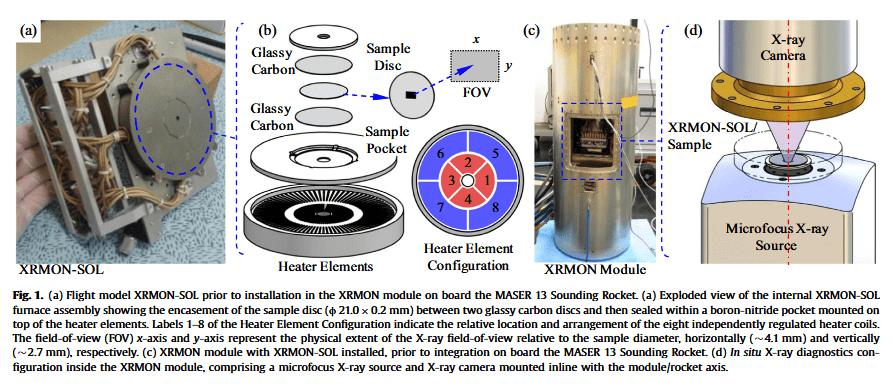Posted on: 18th August 2017 by Dr. Ceri Williams
We’ve been involved in some really fascinating projects over the years. However, the one I’m going to briefly describe in this blog is definitely one of the more unusual ones. Have you ever thought what would happen if you cast aluminium in space? Or, rather more specifically, how solidification changes under zero gravity conditions?
Casting characteristics
Producing useful things from aluminium usually involves starting with molten metal. Hence, one of the most fundamental production routes is simply to pour the molten metal into a mould to produce a casting.
With cast products in particular, it is easy to see how the properties of the resulting component are linked to the solidification process. How the initial crystals nucleate, grow and interact with each other as the molten metal cools and solidifies can cause huge differences in characteristics such as grain size, precipitation and chemical segregation profiles. These then influence the mechanical properties and fracture behaviour of the final component.
The effect of gravity
There are complex physical processes at work at the dynamic solid-liquid interface, which is usually far from equilibrium. On Earth, gravity creates natural convection in the melt. Therefore, where there are density differences between the solid and the liquid, the newly formed crystals may float away from the solidification front and re-melt. Solidification under microgravity is a unique way to remove the effects of buoyancy.
Innoval is working with academic partners at University College Dublin on the European Space Agency XRMON project to investigate the solidification of aluminium alloys under zero gravity conditions. As industrial partners, we’ve supplied some commercial alloy material as well as advice on commercially relevant alloys to study.
How it’s done
In order to fully understand what’s going on during solidification, it is invaluable to ‘see’ the process first-hand. One of the main aims of the project is to record the solidification process in-situ using x-ray radiography. The following video shows an example of grain growth in an Al-20wt%Cu alloy, grain refined with 0.1wt%Al-Ti-B (5/1) master alloy (solidified on ground):
The mechanics of recording such data are difficult enough on earth. However, imagine the added complexity of trying to fit a controlled furnace, and the recording instrumentation, on a 17 inch diameter rocket! To achieve the zero gravity conditions required, the research team must do exactly this. Furthermore, the timing of the experiment has to be perfect. The rocket is fired over 50km above the earth’s surface and experiences weightlessness for only ~6 minutes. It occurs as the payload separates from the fuel source and completes an arc on its return to the ground by parachute.
The team overcame the complex technical challenges with an experimental set-up similar to that shown in the schematics below [1]. They incorporated it into the MASER 13 (MAterial Science Experiment Rocket) seen in Fig.2.


What the results reveal about solidification
Thankfully, the experiment was a resounding success. In microgravity, the team observed the equiaxed grains to be completely immobile during the majority of their growth. This is in comparison to gravity-driven motion and rotations of some grains seen in the ground experiment [1, 2].
The differences are phenomenal when we consider the 3-D structure of the casting and compare the results to terrestrial solidification in the vertical direction. This is normally when extensive grain movement happens. Consequently, this experiment means that for the first time we can attribute the equiaxed grain motion at the later stages of solidification, not to gravity, but to the late-stage shrinkage of the solidifying alloy [3].
The next phase of the project is to see how the results compare with solidification in a more industrially relevant alloy system. As a result, Prof. Browne and his team are expanding on this work by investigating some 7075 material. Watch this space to see how the project unfolds.
Finally, if you’d like to read more about our collaborative research projects, click here.
References:
[1] A.G. Murphy, R.H. Mathiesen, Y. Houltz, J. Li, C. Lockowandt, K. Henriksson, N. Melville, and D.J. Browne, “Direct observation of spatially isothermal equiaxed solidification of an Al-Cu alloy in microgravity on board the MASER 13 sounding rocket”, J. CrystalGrowth, 454, 2016, pp. 96-104
[2] Browne, D.J., “Porosity formation and shrinkage effects in alloy samples solidified on earth and in space as observed in-situ by X-ray monitoring”, TMS Annual Meeting & Exhibition, San Diego, CA, USA, 26 February – 2 March 2017
[3] Velayutham, S., Browne, D.J., “Quantification of equiaxed dendrite motion during spatially isothermal solidification of an Al-Cu alloy in microgravity”, Proc. 6th Decennial International Conference on Solidification Processing, SP17, 25-28 July 2017, Old Windsor, UK. pp. 296-299.



